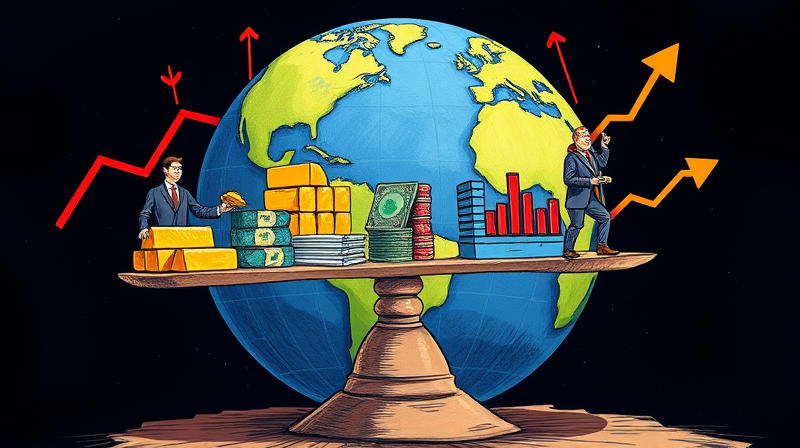As the global economy settles into a new normal, investors face a landscape shaped by evolving growth patterns, shifting policies, and emerging opportunities. Understanding these trends is critical to crafting resilient portfolios in the coming years.
Understanding the Global Growth Trajectory
Global economic growth is projected to hover at 3.3% in both 2025 and 2026, slightly below the historical average of 3.7% recorded from 2000 to 2019. According to EY’s outlook, we can expect real GDP growth remaining stable at around 3.1% in 2025, driven by moderate consumer spending and a rebound in capital investment.
However, the IMF warns that global trade growth will likely underperform output, dipping to just 1.7% in 2025. This divergence signals potential challenges for export-oriented investors but also highlights opportunities in locally focused industries and digital services that are less trade-dependent.
A Closer Look at Regional Outlooks
Economic prospects vary significantly across regions. Investors must tailor their strategies based on local dynamics and policy environments.
United States: A Cooling Yet Resilient Economy
The U.S. growth rate is expected to decelerate from 2.8% in 2024 to between 1.9% and 2.6% in 2025, based on forecasts from S&P and Deloitte. This moderation reflects a transition from an overheated recovery to more sustainable expansion.
- The S&P Global Ratings predicts real GDP growth of 1.9% in 2025.
- Deloitte’s baseline sees 2.6% growth next year, easing to 2.1% in 2026.
- Net economic size is expected to be just 1.55% larger by the end of 2025 versus 3.2% in 2023.
For investors, this means focusing on sectors with steady cash flows and pricing power, as rapid expansion gives way to normalized market conditions. Defensive equities, dividend growers, and quality bonds can play a key role in portfolio stability.
Euro Area and Emerging Markets
The eurozone’s growth has remained muted at about 0.8% in 2024, but a more robust backdrop is anticipated in 2026. This gradual resurgence should benefit exporters in the U.S. and elsewhere.
Meanwhile, regions like Argentina are set to outpace global averages, driven by manufacturing recovery, construction activity, and a revitalized hydrocarbon sector. Investors with a higher risk appetite may explore selective emerging-market debt or equity funds to capture this upside, while managing currency volatility carefully.
Labor Market Dynamics and Implications
The U.S. labor market has normalized, with unemployment stabilizing near 4%—a level lower than most of the past half-century. Wage growth, at around 4.1% year over year for non-supervisory workers, slightly exceeds the 50-year average.
Federal Reserve Chair Jerome Powell notes that the market is now less tight than pre-pandemic levels, signaling a balance between labor demand and supply. For investors, this implies moderate consumer income growth and sustained consumption, supporting sectors like retail, healthcare, and leisure.
Inflation, Monetary Policy, and Investor Positioning
Inflation is expected to ease towards 3.0% in 2025, influenced by residual tariff pressures along domestic supply chains. The Fed plans a single 25-basis-point rate cut, ending the year at 4.00%–4.25% in the federal funds rate.
- Only one rate cut is anticipated for 2025, underscoring cautious policy adjustments.
- Persistent inflation above target complicates bond market forecasts.
- Real yields may stay elevated, favoring high-quality fixed-income instruments.
Investors should consider a barbell approach in bonds, combining short-duration notes to mitigate rate risk with select longer-duration Treasuries or investment-grade paper to lock in attractive yields.
Corporate Earnings and Market Performance
Strong corporate earnings in 2024—up 10% for the S&P 500—were driven by margin expansion and solid demand across sectors. Q4 earnings rose roughly 18% year over year, with ten of eleven sectors contributing positively, led by financials.
- Margins added over 13 percentage points to overall growth.
- Earnings gains have broadened beyond the tech giants, with most sectors enjoying healthy profits.
- Financials, industrials, and consumer staples are expected to sustain momentum in 2025.
For equity investors, this broadening trend suggests opportunities in mid-cap and small-cap stocks that benefit from domestic growth and niche leadership rather than relying solely on mega-cap tech names.
Policy Shifts, Trade Dynamics, and Supply Chains
Recent policy changes, including higher tariffs and federal workforce adjustments, have created early disruptions in growth. While front-loaded measures may weigh on trade flows in 2025, promised deregulation and tax incentives could unlock stronger productivity gains in an upside scenario.
Global supply chains have largely normalized from pandemic bottlenecks. With tariff structures expected to clarify by 2026, businesses may shift from precautionary early shipments to more balanced sourcing strategies, benefiting logistics firms and technology providers that optimize supply networks.
Wage Growth, Productivity, and Long-Term Opportunities
Sustained productivity improvements are essential to preventing wage inflation from reigniting broader price pressures. As immigration inflows moderate, modest wage increases could support consumer spending without derailing the inflation outlook.
Investors should consider exposure to companies investing heavily in automation, digital transformation, and workforce training, as these firms are poised to outperform in an environment that values productivity gains.
Conclusion: Crafting a Resilient Investment Strategy
Post-pandemic economic trends underscore a world of measured growth, evolving policy frameworks, and region-specific opportunities. Investors who diversify across geographies, balance risk with quality positions, and remain agile in portfolio allocation will be best positioned to navigate this new era.
Embrace strategic asset allocation by combining defensive yields, growth-oriented equities, and tactical sector bets aligned with labor, inflation, and policy cycles. In doing so, you can build portfolios that thrive amid modest momentum, normalize market conditions, and unlock sustainable returns in the years ahead.
References
- https://www.imf.org/en/Blogs/Articles/2025/04/22/the-global-economy-enters-a-new-era
- https://www2.deloitte.com/us/en/insights/economy/global-economic-outlook-2025.html
- https://www2.deloitte.com/us/en/insights/economy/us-economic-forecast/united-states-outlook-analysis.html
- https://www.imf.org/en/Publications/WEO/Issues/2025/01/17/world-economic-outlook-update-january-2025
- https://www.spglobal.com/ratings/en/research/articles/250325-economic-outlook-u-s-q2-2025-losing-steam-amid-shifting-policies-13450076
- https://www.federalreserve.gov/newsevents/speech/powell20240823a.htm
- https://www.ey.com/en_us/insights/strategy/global-economic-outlook
- https://am.jpmorgan.com/us/en/asset-management/adv/insights/market-insights/guide-to-the-markets/economic-and-market-update/










